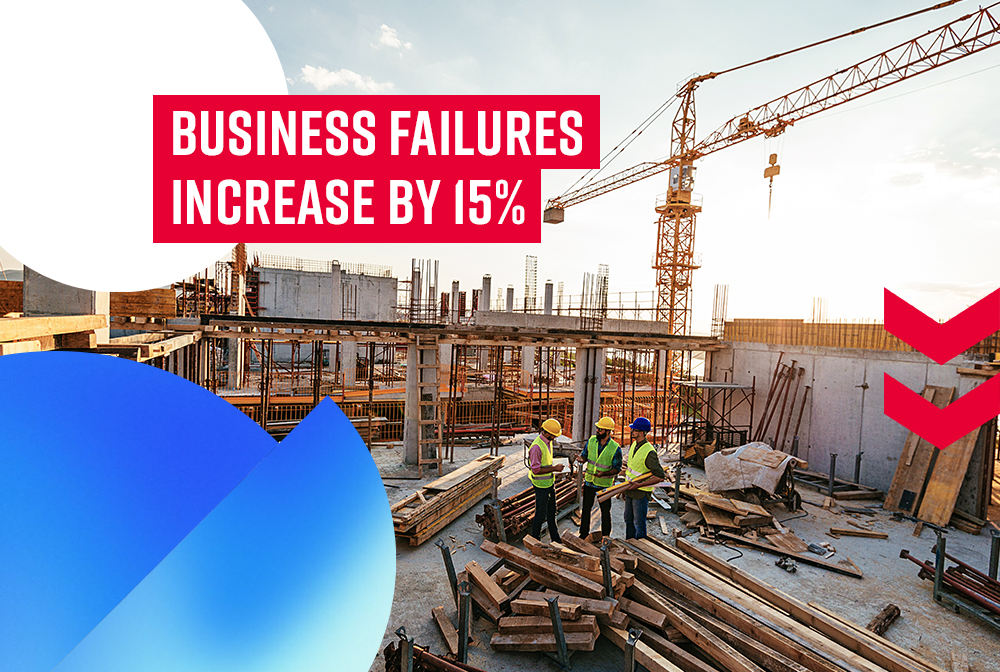
The latest statistics by the Australian Securities and Investment Commission (ASIC) for the June quarter 2019 reveal that Australian company defaults[1] (EXADs) continue to rise. NSW accounted for half of the increase, with the construction sector shown to be a significant contributor. And while defaults are up in the south-eastern and western regions, the opposite appears true of northern Australia.
- 15% increase in companies experiencing external administration (EXAD) in the June 2019 quarter compared with the previous quarter
- Annual growth of company defaults now at 5% year-on-year (YoY)
Head of Product and Rating Services at Equifax, Brad Walters, said the increase in company defaults is the result of several factors, including the deterioration of firm trading conditions and profitability.
“While some surveys suggest business confidence has improved, business conditions remain challenging, particularly for low- and mid-tier firms[2],” Walters says.
“Lending to business reduced 16.5% in June 2019, seasonally adjusted, and now reflects a 4.4% decrease over the year[3]. The Reserve Bank sees these tighter lending conditions as possibly pushing small businesses into default.”
“In addition to domestic factors, business confidence is likely to be impacted by the continuing trade-tensions across Asia-Pacific. Updated IMF forecasts show global growth has reduced to its slowest pace since the global financial crisis, with growing uncertainties and major economic risks.”
NSW a standout in regional differences
The south-eastern region – NSW, ACT and Victoria – experienced a 17% increase in defaults for the June 2019 quarter, compared with the previous quarter. In Western Australia, defaults were up by 40%.
In the June 2019 quarter, NSW-based companies showed their susceptibility to default, with 52% of the increase in defaults Australia-wide coming from NSW companies. NSW observed a 24% increase in EXADs over the previous quarter (QoQ) and represented 36% of total EXADs for the quarter.
Bucking the trend of rising defaults, the northern region of Australia – QLD and NT – experienced a 4% decrease in EXADs. Queensland has now experienced three consecutive quarters of reduced defaults (QoQ).
- NSW: Defaults increased by 24% QoQ. Up 8% YoY
- VIC: Defaults increased by 6% QoQ. Up 8% YoY
- ACT: Defaults increased by 68% QoQ. Up 7% YoY
- QLD: Defaults decreased by 4% QoQ. Up 2% YoY
- NT: Defaults decreased by 30% QoQ. Down 21% YoY
- WA: Defaults increased by 40% QoQ. Down 8% YoY
- SA: Defaults increased by 66% QoQ. Up 2% YoY
- TAS: Defaults deceased by 26% QoQ. Up 46% YoY
- AUS: Defaults increased by 15% QoQ. Up 5% YoY.
The most substantial portion of quarterly defaults came from the south-eastern region (65%), with NSW accounting for 36% and Victoria for 27% of all EXADs. Queensland accounted for 18% of all EXADs, WA represented 11% of all EXADs, and the remaining 6% were across SA and Tasmania.
Construction among the sectors to struggle
There was a rise in insolvencies in the June 2019 quarter among the top three default-contributing sectors.
- Construction: defaults increased by 18% QoQ and 12% annually (YoY)
- Other Business and personal services[4]: defaults increased by 29% QoQ and 2% annually (YoY)
- Accommodation and food services: default increased by 6% QoQ and 13% annually (YoY).
Australia’s south-eastern (SE) region suffered the brunt of construction industry defaults, accounting for 71% of June 2019 quarter EXADs. Of these SE region construction companies that failed, 42% were from NSW. Of the companies in NSW that failed, 22% were from the construction sector.
“The increase in construction defaults shouldn’t be a surprise,” Walters said. “Recent quarterly results for construction activity and construction work have shown a continued downward trend. For construction work, there have been three consecutive quarters of falls.”
Construction sector snapshot
- Decrease of 7.5% in construction company gross operating profits, seasonally adjusted, reported in the March 2019 quarter[5].
- Total dwelling approvals have fallen for 19 consecutive months, and June 2019 approvals are 19% lower year-on-year[6].
- The value of new residential building approvals has declined for the last 17 months, and June 2019 was 16% lower year-on-year[7].
- The value of engineering construction ‘work done’ has contracted for four quarters, and the March 2019 quarter was 12% lower than a year ago[8].
Mining sector experiences a significant rise in defaults
Mining sector defaults were noticeably up. Increasing by 40% over the June 2019 quarter (QoQ), defaults from this sector were observed as 56% higher than the prior comparable period (PcP). Annual defaults year-over-year are 16% higher, with Western Australian companies contributing to 61% of mining EXADs.
“The increase in mining defaults is possibly explained by the decrease in pre-tax mining profits from the March quarter,” said Walters. “I’d anticipate the defaults have largely come from the smaller players and those providing mining support services.”
Mining sector snapshot[9]
- For the first time in two years, the March 2019 quarter reported an overall decline in the value of commodity exports.
- This decline was primarily impacted by the decreased value of coal, petroleum and other energy exports.
- Decrease of 18% in mining company pre-tax profits for the March 2019 quarter (QoQ)
- For the first time in 18 months, there was a decrease in quarterly bank lending in March 2019.
Some positive news for retail
Retail was one of the few sectors to experience a decrease in defaults. In the June 2019 quarter, EXADs were observed to fall 5% from the previous quarter. Following on from a substantial increase in defaults in the March quarter, annual defaults year-on-year are now 1% lower.
“While retail is doing it tough and the overall retail environment remains subdued, five of the six retail trade categories experienced small improvements in turnover for the June quarter,’’ Walters said.
Retail sector snapshot[10]
- Overall the retail trading results showed an increase of 0.2% for the June 2019 quarter, in seasonally adjusted volume terms.
- The quarterly rise in retail volumes was led by department stores (1.4%); cafes, restaurants and takeaway food services (0.5%); clothing, footwear and personal accessory retailing (0.7%); other retailing (0.4%); and household goods retailing (0.1%).
Troubling times for health care and social assistance
Defaults in the health care and social assistance sector increased 39% over the June 2019 quarter (QoQ), and defaults are up 23% over the last 12 months.
“This sector is experiencing a massive shakeup with the Royal Commission into Aged Care Quality and Safety,” said Walters. “Troubles may be expected as the aged care industry grapples with wide-ranging systematic issues.”
Unsecured creditors remain vulnerable
When businesses fail, unsecured creditors can be left exposed to massive financial loss. With receivers working to recover monies and limit a financier’s exposure, there is often little left for unsecured creditors. In the construction sector, for example, creditor wind-ups account for 54% of administration appointments and 96% of unsecured creditors receive back less than 11 cents in the dollar[11].
These insolvency statistics are a timely reminder of the vital role financial insights can play in effective risk management. Financial statement analysis has been shown to provide more than a 40% uplift in predicting default for businesses whose turnover is more than five million[12].
Did you know?
- 8,105 companies entered EXAD in the twelve months to June 2019.
- While half of the Australia-wide defaults emanate from creditor wind-ups, the quarterly results to June 2019 showed a significant increase in voluntary administrations.
- Rental, hiring and real estate defaults increased 45% over the June 2019 quarter (QoQ), being 9% higher than the PcP and rising 14% YoY.
- Defaults from the transport, postal and warehousing sector were 16% up over the June 2019 quarter (QoQ), but 9% lower than the PcP and 10% lower YoY.
- Defaults from the professional, scientific and technical services were 19% up over the June 2019 quarter (QoQ), but 3% lower than the PcP and 6% lower YoY.
- Wholesale trade experienced a 26% decline in defaults over the June 2019 quarter (QoQ), however, was only 3% lower PcP, and remains 11% up YoY.
- While manufacturing defaults were only up 3% over the quarter (QoQ), they were 27% higher than the PcP and 1% down YoY.
- While agriculture, forestry and fishing defaults were significantly up over the June 2019 quarter, they were 3% down on the PcP and 25% lower YoY.
Email us to find out some of the ways you can help protect your business from insolvency.
[1] Companies entering external administration (EXADs), ranging from court wind-ups, creditor wind-ups, receiver appointments, voluntary administration, etc
[2] EFX, and NAB’s Small and Medium Enterprise (SME) business survey
[3] Australia Bureau of Statistics (ABS), 5601.0, Jun 2019
[4] Other business and personal services includes repairs and maintenance, hairdressing and personal care services, funeral and cemetery services, laundry, parking and other services, religious services, and private households employing staff
[5] ABS, 5676.0, Mar 2019
[6]. ABS, 8731.0, Jun 2019
[7] ABS, 8731.0, Jun 2019
[8] ABS8755.0, ABS 8762.0, ABS 8782.0.65.001 – Mar 2019. NB: ‘a year ago’ refers to the prior comparable period, not a year-on-year change
[9] Office of the Chief Economist (OCE) Resources and Energy Quarterly (REQ), Jun 2019
[10] ABS 8501.0, Jun 2019
[11] ASIC, Australian Insolvency Statistics
[12] EFX and Equifax analysis using financial statements of 12,500 businesses, commercial bureau and trade payment data


